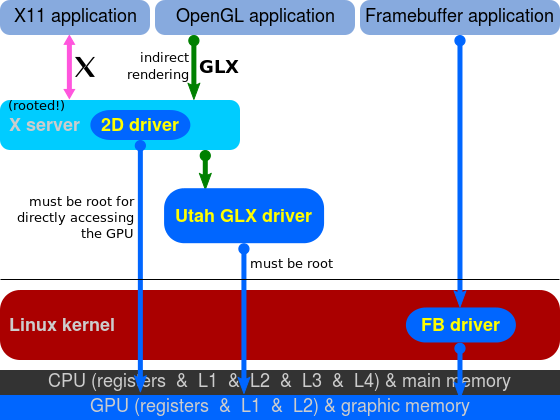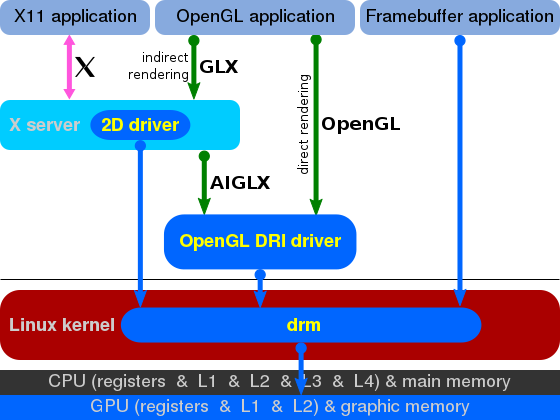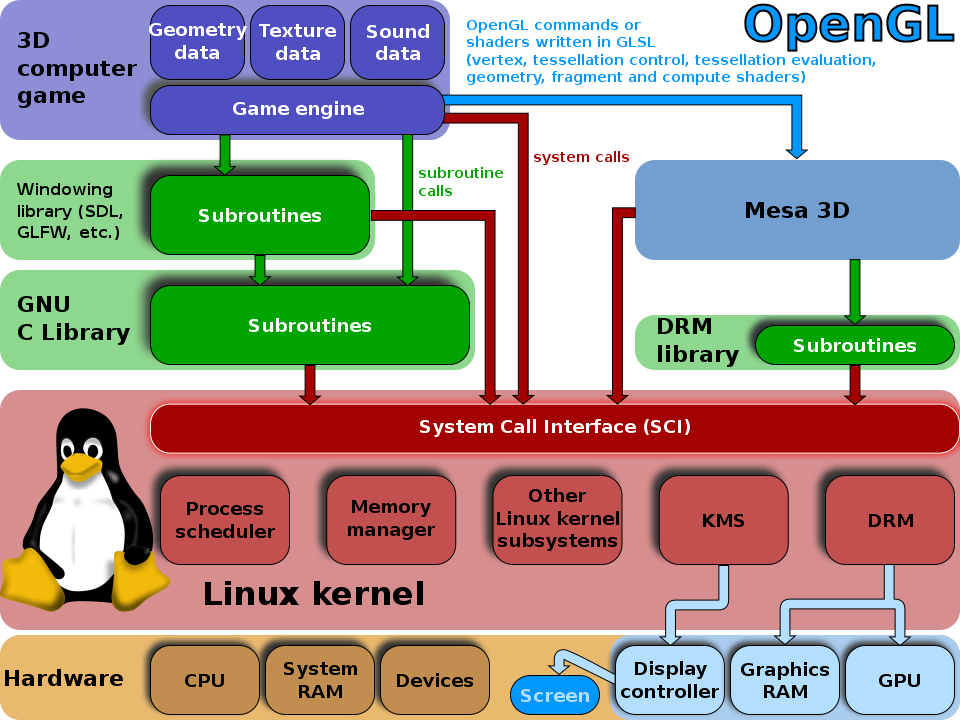Linux graphics stack
2D图形架构
早期Linux图形系统的显示全部依赖X Server,X Client调用Xlib提供的借口向 X Server发送渲染命令,X Server根据 X Client的命令请求向硬件设备绘制图形,X Client与X Server之间通过X11协议通讯。通过这种方式,X Server屏蔽了所有的硬件差异,保证同一个X程序能够在不同的硬件设备上运行。
X Server需要与多种多样的硬件打交道,每个硬件提供自己的DDX驱动程序,X Server最后调用DDX的接口将图形发送给硬件设备。

3D图形架构
通过3D硬件执行3D加速能够大大提高绘制效率,根据不同的模式有两种架构:
Indirect Rendering
这种模式下,仅仅X Server能够访问3D硬件设备,X Client需要绘图时通过X11扩展协议将3D命令发送给X Server,然后由X Server控制3D硬件设备执行,这种模式称为“非直接渲染”。
这种模式与2D模式类似。

但是这种模式无法发挥出3D硬件的效率
Direct Rendering
DRI(Direct Rendering Infrastructure)架构允许X Client直接控制3D硬件设备,所以这种模式下要求X Client与X Server必须位于同一个设备上。
DRM(Direct Rendering Manager)是DRI架构下的Kernel实现,DRM负责:hardware locking, access synchronization, video memory and more.
DRM also provides userspace with an API that it can use to submit commands and data in a format that is adequate for modern GPUs, which effectively allows userspace to communicate with the graphics hardware.
Notice that many of these things have to be done specifically for the target hardware so there are different DRM drivers for each GPU.

DRI/DRM provide the building blocks that enable userspace applications to access the graphics hardware directly in an efficient and safe manner, but in order to use OpenGL we need another piece of software that, using the infrastructure provided by DRI/DRM, implements the OpenGL API while respecting the X server requirements.
Mesa
Mesa is a free software implementation of the OpenGL specification, and as such, it provides a libGL.so, which OpenGL based programs can use to output 3D graphics in Linux. Mesa can provide accelerated 3D graphics by taking advantage of the DRI architecture to gain direct access to the underlying graphics hardware in its implementation of the OpenGL API.
When our 3D application runs in an X11 environment it will output its graphics to a surface (window) allocated by the X server. Notice, however, that with DRI this will happen without intervention of the X server, so naturally there is some synchronization to do between the two, since the X server still owns the window Mesa is rendering to and is the one in charge of displaying its contents on the screen. This synchronization between the OpenGL application and the X server is part of DRI. Mesa’s implementation of GLX (the extension of the OpenGL specification that addresses the X11 platform) uses DRI to talk to the X server and accomplish this.
Mesa also has to use DRM for many things. Communication with the graphics hardware happens by sending commands (for example “draw a triangle”) and data (for example the vertex coordinates of the triangle, their color attributes, normals, etc). This process usually involves allocating a bunch of buffers in the graphics hardware where all these commands and data are copied so that the GPU can access them and do its work. This is enabled by the DRM driver, which is the one piece that takes care of managing video memory and which offers APIs to userspace (Mesa in this case) to do this for the specific target hardware. DRM is also required whenever we need to allocate and manage video memory in Mesa, so things like creating textures, uploading data to textures, allocating color, depth or stencil buffers, etc all require to use the DRM APIs for the target hardware.

引用原文:https://blogs.igalia.com/itoral/2014/07/29/a-brief-introduction-to-the-linux-graphics-stack/
Linux graphics stack的更多相关文章
- Monitoring and Tuning the Linux Networking Stack: Receiving Data
http://blog.packagecloud.io/eng/2016/06/22/monitoring-tuning-linux-networking-stack-receiving-data/ ...
- Queueing in the Linux Network Stack !!!!!!!!!!!!!!!
https://www.coverfire.com/articles/queueing-in-the-linux-network-stack/ Queueing in the Linux Networ ...
- Linux Storage Stack Diagram存储堆栈图
这是一个描述非常好的存储栈,版本为:Linux Storage Stack Diagram v4.10,我在这里转载下图片,可以提升大家对存储栈的理解. https://www.thomas-kren ...
- Linux Kernel Stack
整理一些杂乱的内容.以下x86架构. Linux 内核栈大小 内核栈大小是固定的,默认为8k,曾经有选项可以设置为4k栈.由于大小固定,申请过大的栈内存,或者函数调用层次过深,都可能导致栈溢出. 关注 ...
- 《Monitoring and Tuning the Linux Networking Stack: Receiving Data》翻译
Overview 从宏观的角度来看,一个packet从网卡到socket接收缓冲区的路径如下所示: 驱动加载并初始化 packet到达网卡 packet通过DMA被拷贝到内核中的一个ring buff ...
- The Linux Storage Stack Diagram
相关文章: 如何提高Linux下块设备IO的整体性能?
- linux io stack
- The Linux Storage Stack Diagram 内核 4.0 版的 I/O 栈
- Linux Storage Stack Diagram 4.0
https://www.thomas-krenn.com/en/wiki/Linux_Storage_Stack_Diagram
随机推荐
- SDNUOJ1016矩形合并
传送门 题意: 给出n个矩形,把重合的矩形归成一个图形,问合并以后剩下几个图形 思路: 我开始想用dfs,但是发现不太行. 后来知道才是并查集 Orz 用一个结构体数组存矩形的左下角和右上角的坐标,再 ...
- 2019 沈阳网络赛 D Fish eating fruit ( 树形DP)
题目传送门 题意:求一颗树中所有点对(a,b)的路径长度,路径长度按照模3之后的值进行分类,最后分别求每一类的和 分析:树形DP \(dp[i][j]\) 表示以 i 为根的子树中,所有子节点到 i ...
- [CERC2014]Virus synthesis【回文自动机+DP】
[CERC2014]Virus synthesis 初始有一个空串,利用下面的操作构造给定串 SS . 1.串开头或末尾加一个字符 2.串开头或末尾加一个该串的逆串 求最小化操作数, \(|S| \l ...
- POJ1113:Wall (凸包算法学习)
题意: 给你一个由n个点构成的多边形城堡(看成二维),按顺序给你n个点,相邻两个点相连. 让你围着这个多边形城堡建一个围墙,城堡任意一点到围墙的距离要求大于等于L,让你求这个围墙的最小周长(看成二维平 ...
- B. Modular Equations
Last week, Hamed learned about a new type of equations in his math class called Modular Equations. L ...
- Power Strings POJ - 2406 后缀数组
Given two strings a and b we define a*b to be their concatenation. For example, if a = "abc&quo ...
- HDU 3416 Marriage Match IV (最短路径&&最大流)
/*题意: 有 n 个城市,知道了起点和终点,有 m 条有向边,问从起点到终点的最短路一共有多少条.这是一个有向图,建边的时候要注意!!解题思路:这题的关键就是找到哪些边可以构成最短路,其实之前做最短 ...
- Codeforces Round #670 (Div. 2) A. Subset Mex (贪心)
题意:给你一长度为\(n\)的序列,将其分为两个集合,求两个集合中未出现的最小元素的最大值, 题解:用桶存一下每个元素的个数,两次枚举\([1,100]\),找出两个最小值即可. 代码: int t; ...
- 在kubernetes集群里集成Apollo配置中心(1)之交付Apollo-adminservice至Kubernetes集群
1.部署apollo-adminservice软件包 apollo-adminservice软件包链接地址:https://github.com/ctripcorp/apollo/releases/d ...
- LINUX - Libevent
参考: https://dulishu.top/libevent-event-loop/
